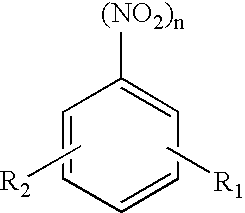Process for the production of aromatic amines by heterogeneously catalysed hydrogenation
a technology of aromatic amines and hydrogenation, which is applied in the preparation of organic compounds, amino-hyroxy compounds, organic chemistry, etc., can solve the problems of low specific loading of catalysts, affecting the effective dissipation of heat in this method, and unsatisfactory space-time yield in industrial-scale processes. , to achieve the effect of increasing the service life of the isothermal main reactor, increasing the space-time yield, and large hydrogen excess
- Summary
- Abstract
- Description
- Claims
- Application Information
AI Technical Summary
Benefits of technology
Problems solved by technology
Method used
Image
Examples
example 1
Production of Catalytically Coated Monolithic Honeycombs
Cylindrical honeycombs of cordierite with a length of 152 mm, a diameter of 30.5 mm and a cell density of 400 cpsi were used as monolithic supports. The monolithic supports were cleaned, dried and weighed before coating. The composition of the supported, catalytically active components used as the catalytically active coating was as follows: 9 g palladium, 9 g vanadium and 3 g lead per liter of spherical alpha-aluminium oxide. (A detailed description of the supported catalyst can be found in DE-A 28 49 002, believed to correspond to U.S. Pat. No. 4,265,834, the disclosure of which is hereby incorporated by reference.) From these supported, catalytically active components, a powder with a particle size of d50.3=1.7 μm and d90.3=4.9 μm was produced by comminution and extremely fine grinding prior to coating.
For the coating suspension, a solution of 3.2 g of 25 wt. % aqueous ammonium polymethacrylate solution (“Darvan C” from ...
example 2
Standard Bed (Comparative Example)
A tubular reactor thermostatically controlled with oil, having an internal diameter of 26 mm and a length of 3000 mm, was filled with a catalyst as described in DE-A 28 49 002 which is believed to correspond to U.S. Pat. No. 4,265,834, the disclosure of which is hereby incorporated by reference. A protective tube with a mobile thermocouple was located in the center of the tubular reactor to detect the temperature in the catalyst bed. The catalyst was flushed first with nitrogen and then with hydrogen, and was then activated with 1,000 l / h hydrogen at 240° C. over a period of 49 h.
Nitrobenzene was then evaporated in a mixture of nitrogen and hydrogen. The nitrobenzene loading was slowly increased from 134 g / h to the maximum value of 690 g / h in such a way that the maximum temperature in the bed did not rise above 460° C. In this phase, an 820 l / h volume flow of the mixture was passed through the reaction tube, maintaining a 4 to 1 molar ratio of h...
example 3
Use of the Monolithic Honeycomb (Example of an Embodiment)
Monolithic honeycombs produced according to Example 1 were used as catalysts in a tubular reactor thermostatically controlled with oil, having an internal diameter of 32.8 mm. Five (5) honeycombs, each with a length of 150 mm and a diameter of 30.5 mm, were introduced into the reaction tube. The active catalyst material deposited on these 5 honeycombs i.e. support substance and catalytically active component, totalled 37.5 g. The gap between the tube wall and the honeycomb was sealed with a heat-resistant fleece (Carborundum, type FT 1). A protective tube with a mobile thermocouple was located in the center of the tubular reactor to detect the temperature in the monolithic honeycomb. The catalyst was flushed first with nitrogen and then with hydrogen, and was finally activated with 500 l / h hydrogen at 300° C. over a period of 3 h.
Nitrobenzene was then evaporated in a mixture of nitrogen and hydrogen. The nitrobenzene load...
PUM
| Property | Measurement | Unit |
|---|---|---|
| thickness | aaaaa | aaaaa |
| thickness | aaaaa | aaaaa |
| thickness | aaaaa | aaaaa |
Abstract
Description
Claims
Application Information
 Login to View More
Login to View More - R&D
- Intellectual Property
- Life Sciences
- Materials
- Tech Scout
- Unparalleled Data Quality
- Higher Quality Content
- 60% Fewer Hallucinations
Browse by: Latest US Patents, China's latest patents, Technical Efficacy Thesaurus, Application Domain, Technology Topic, Popular Technical Reports.
© 2025 PatSnap. All rights reserved.Legal|Privacy policy|Modern Slavery Act Transparency Statement|Sitemap|About US| Contact US: help@patsnap.com


